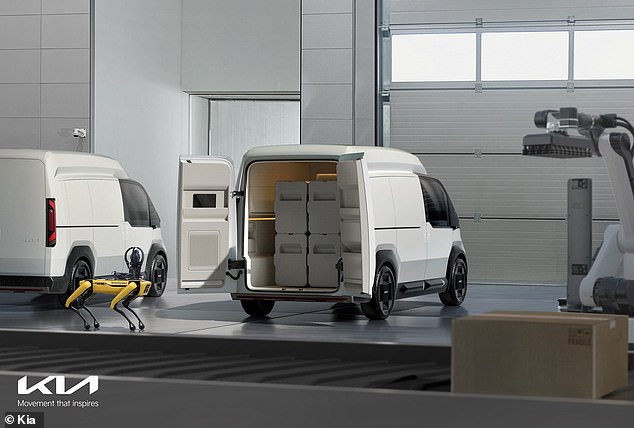Not content with achieving massive success in the electric car arena with its award-winning EV6 and e-Niro, Kia is entering the electric van market… but with a twist.
The Korean brand has unveiled three concept commercial electric vehicles at the Consumer Electronics Show in Vegas this week, with the first – the PV5 – set to arrive in 2026.
All three vans – including the PV1 and PV7 – are based on the Korean brand’s new Purpose Built Vehicle (PVB) system, which Kia says prioritises ‘extensive modularity’.
That means they can be used as commercial vehicles during the week and converted to campervans for when you want a weekend away.

Kia’s unveiled three concept electric vans using a customisable Purpose Built Vehicle (PVB) system. The image shows the PV5 (two models pictured middle) as a commercial vehicle and an MPV
With the PV5 leading the way as part of Kia’s ‘Beyond Mobility’ strategy, all sequential PV models will feature ‘Easy Swap’ technology that fulfils different mobility needs.
While the front cab is fixed the rear is interchangeable.
Different ‘life modules’ that make up the rear portion or upper body of each vehicle can be switched in and out using mechanical coupling and electromagnetic tech – something a dealer would be responsible to carry out.
So, the PV5 could be a van during a week and then double as a people carrier when it’s time to carpool kids over the weekend. It can even be converted to a campervan or taxi.
Kia says it has designed the PVB platform for such a level of ‘enhanced versatility’.

‘Life modules’ allow for the rear portion of the vehicle to be swapped in and out, turning the PV5 into a MPV, camper van or taxi

Kia offers ‘exceptional flexibility and customisation through radical modularisation’
Initially, Kia is launching the PV5 with a focus on commercial use, with the Basic, Van, High Roof and Chassis Cab versions first to hit the market.
There’s an emphasis on design simplicity with clever twists, though the marque adds that high-quality, dependability and capability will make PV models functionable for all demands.
Karim Habib, executive vice president and head of Kia Global Design said: ‘Kia PBVs will initiate a new era of seamless everyday business and lifestyle solutions.
‘We hope to make our customers’ lives easier and better, whether they’re stationary or on the move, offering exceptional flexibility and customisation through radical modularisation.’
All PV5 models have large doors that open to pillarless, wide and flat load spaces with integrated rails for maximum versatility.
The cab even comes with a desk-like dash that can double-up as an office on wheels – similar to that of the electric Ford E-Transit Custom.

The PV5 cab doubles up as a mobile office with dash to desk design and huge infotainment screens

The multi-way interior is removable and configurable to accommodate all mobility needs
The futuristic practicality is matched with Sci-Fi looks – clean, curved one-box bodies with slit-thin LED headlights made from sustainable materials.
By using bio plastic, bio paint, recycled PET fabric, felt and yarns Kia wants to ‘deliver a unique visual and tactile appeal […] that limits environmental impact today and tomorrow’.
Tech of tomorrow is another theme to come out of Kia’s launch.
The PV5 will include advanced software connectivity as a nod towards phase two and three of Kia’s commercial vehicle plans which include integrated AI and autonomous driving and delivery services.

PV models will have integrated AI and advanced software connectivity for a personalised experience
Book it as a taxi and it’ll turn up with your name displayed front and back in bold font. Want to enjoy the sunshine? The transparent roof is also a perovskite solar cell roof that charges the battery on the move and delivers electricity direct to the plug next to your seat.
Prices have yet to be confirmed but it’s expected that Kia will target an entry price of around £30,000.
No detail has been released on the PV5’s powertrain either but it’s likely to share batteries and motors from Kia’s electric SUVs such as the EV6 and EV9. This could put the predicted range of up to 349 miles (using the EV9’s 95kWh battery).
The PV7 will go up against Ford’s E-Transit (which has a range of 236 miles) when it arrives in 2017 and will come with the option of four-wheel drive.
The PV1 on the other hand will be designed for short distance agile urban transportation.
These models complete phase two of Kia’s ‘Beyond Mobility’ strategy.
Phase three will deliver bespoke mobility solutions to fleets as part of a ‘smart city’ system, with self-driving PV5 Robotaxi fitted with Kia’s Level 4 autonomous driving technology.
Some links in this article may be affiliate links. If you click on them we may earn a small commission. That helps us fund This Is Money, and keep it free to use. We do not write articles to promote products. We do not allow any commercial relationship to affect our editorial independence.





